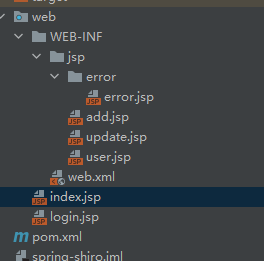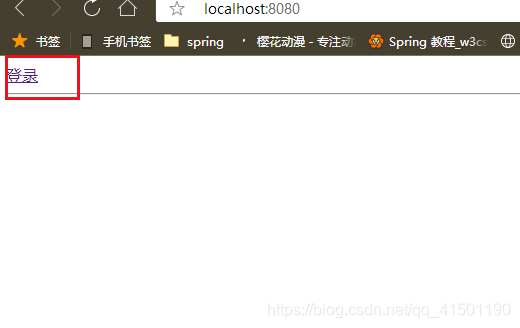SSM + jsp整合shiro_ssm+jsp整合shiro-程序员宅基地
1.首先整合SSM框架,起码项目要能跑起来
以前整合好的ssm框架
springmvc-config.xml
<?xml version="1.0" encoding="UTF-8"?>
<beans xmlns="http://www.springframework.org/schema/beans"
xmlns:xsi="http://www.w3.org/2001/XMLSchema-instance"
xmlns:mvc="http://www.springframework.org/schema/mvc"
xmlns:context="http://www.springframework.org/schema/context"
xsi:schemaLocation="http://www.springframework.org/schema/beans http://www.springframework.org/schema/beans/spring-beans.xsd
http://www.springframework.org/schema/mvc http://www.springframework.org/schema/mvc/spring-mvc.xsd
http://www.springframework.org/schema/context https://www.springframework.org/schema/context/spring-context.xsd">
<!-- 注解驱动 -->
<mvc:annotation-driven/>
<!-- 静态资源路径 -->
<mvc:default-servlet-handler/>
<!-- 扫描controller包 -->
<context:component-scan base-package="com.kuang.controller"/>
<!-- 视图解析器 -->
<bean id="internalResourceViewResolver" class="org.springframework.web.servlet.view.InternalResourceViewResolver">
<property name="prefix" value="/WEB-INF/jsp/"/>
<property name="suffix" value=".jsp"/>
</bean>
</beans>
spring-dao.xml
<?xml version="1.0" encoding="UTF-8"?>
<beans xmlns="http://www.springframework.org/schema/beans"
xmlns:xsi="http://www.w3.org/2001/XMLSchema-instance"
xmlns:context="http://www.springframework.org/schema/context"
xsi:schemaLocation="http://www.springframework.org/schema/beans http://www.springframework.org/schema/beans/spring-beans.xsd http://www.springframework.org/schema/context https://www.springframework.org/schema/context/spring-context.xsd">
<!-- 导入本地jdbc配置 -->
<context:property-placeholder location="classpath:jdbc.properties"/>
<!-- DataSource:使用spring数据源替换mybatis的配置 -->
<bean id="dataSource" class="org.springframework.jdbc.datasource.DriverManagerDataSource">
<property name="driverClassName" value="${jdbc.driver}"/>
<property name="url" value="${jdbc.url}"/>
<property name="username" value="${jdbc.username}"/>
<property name="password" value="${jdbc.password}"/>
</bean>
<!-- sqlSessionFactory -->
<bean id="sqlSessionFactory" class="org.mybatis.spring.SqlSessionFactoryBean">
<!-- 配置数据源 -->
<property name="dataSource" ref="dataSource"/>
<!-- 配置mybatis配置文件 -->
<property name="configLocation" value="classpath:mybatis-config.xml"/>
<!-- 自动扫描Mapper -->
<property name="mapperLocations" value="classpath:com/kuang/mapper/*.xml"/>
</bean>
<!-- 自动生成userMapper实现类 -->
<bean id="mapperScannerConfigurer" class="org.mybatis.spring.mapper.MapperScannerConfigurer">
<property name="basePackage" value="com.kuang.mapper"/>
</bean>
</beans>
spring-service.xml
<?xml version="1.0" encoding="UTF-8"?>
<beans xmlns="http://www.springframework.org/schema/beans"
xmlns:xsi="http://www.w3.org/2001/XMLSchema-instance"
xmlns:context="http://www.springframework.org/schema/context"
xmlns:aop="http://www.springframework.org/schema/aop"
xsi:schemaLocation="http://www.springframework.org/schema/beans http://www.springframework.org/schema/beans/spring-beans.xsd http://www.springframework.org/schema/context https://www.springframework.org/schema/context/spring-context.xsd http://www.springframework.org/schema/aop https://www.springframework.org/schema/aop/spring-aop.xsd">
<!-- 扫描service包 -->
<context:component-scan base-package="com.kuang.service"/>
<import resource="classpath:spring-dao.xml"/>
<!-- 声明式事务 -->
<bean id="transactionManager" class="org.springframework.jdbc.datasource.DataSourceTransactionManager">
<property name="dataSource" ref="dataSource"/>
</bean>
</beans>
application.xml
<?xml version="1.0" encoding="UTF-8"?>
<beans xmlns="http://www.springframework.org/schema/beans"
xmlns:xsi="http://www.w3.org/2001/XMLSchema-instance"
xmlns:context="http://www.springframework.org/schema/context"
xsi:schemaLocation="http://www.springframework.org/schema/beans http://www.springframework.org/schema/beans/spring-beans.xsd http://www.springframework.org/schema/context https://www.springframework.org/schema/context/spring-context.xsd">
<import resource="classpath:springmvc-config.xml"/>
<import resource="classpath:spring-dao.xml"/>
<import resource="classpath:spring-service.xml"/>
</beans>
jdbc.properties
jdbc.driver = com.mysql.cj.jdbc.Driver
jdbc.url = jdbc:mysql://localhost:3306/student?characterEncoding=utf8
jdbc.username = root
jdbc.password = 1511
2.新建spring-shiro配置文件
<?xml version="1.0" encoding="UTF-8"?>
<beans xmlns="http://www.springframework.org/schema/beans"
xmlns:xsi="http://www.w3.org/2001/XMLSchema-instance"
xsi:schemaLocation="
http://www.springframework.org/schema/beans http://www.springframework.org/schema/beans/spring-beans-4.1.xsd
"
default-lazy-init="true">
<!--1. 配置securityManager安全管理器 -->
<!--
SecurityManager:安全管理器;即所有与安全有关的操作都会与SecurityManager交互;
且它管理着所有Subject;可以看出它是Shiro 的核心,它负责与后边介绍的其他组件进行交互
-->
<bean id="securityManager" class="org.apache.shiro.web.mgt.DefaultWebSecurityManager">
<property name="realm" ref="shiroDbRealm" />
</bean>
<!--2. 配置 CacheManager. 2.1需要加入 ehcache 的 jar 包及配置文件. -->
<bean id="cacheManager" class="org.apache.shiro.cache.MemoryConstrainedCacheManager"> </bean>
<!--3.配置realm 自定义的Realm-->
<!--
Shiro 从从Realm获取安全数据(如用户、角色、权限),就是说SecurityManager要验证用户身份,
那么它需要从Realm获取相应的用户进行比较以确定用户身份是否合法;
也需要从Realm得到用户相应的角色/权限进行验证用户是否能进行操作;
可以把Realm看成DataSource , 即安全数据源
-->
<bean id="shiroDbRealm" class="com.kuang.auth.realm.UserRealm"></bean>
<!--4.配置lifecycleBeanPostProcessor,可以自动调用spring ioc 容器中的shiro bean 的生命周期方法 -->
<!-- 开启Shiro注解的Spring配置方式的beans。在lifecycleBeanPostProcessor之后运行 -->
<bean id="lifecycleBeanPostProcessor" class="org.apache.shiro.spring.LifecycleBeanPostProcessor" />
<!--5. 启用 IOC 容器中使用 shiro 的注解. 但必须在配置了 LifecycleBeanPostProcessor 之后才可以使用. -->
<bean class="org.springframework.aop.framework.autoproxy.DefaultAdvisorAutoProxyCreator"
depends-on="lifecycleBeanPostProcessor">
<property name="proxyTargetClass" value="true" />
</bean>
<!-- Shiro Filter id值和web.xml文件配置的过滤器名称相同 -->
<bean id="shiroFilter"
class="org.apache.shiro.spring.web.ShiroFilterFactoryBean">
<property name="securityManager" ref="securityManager" />
<!-- 登录页面 -->
<!--<property name="loginUrl" value="/login.jsp" />-->
<!-- 登录成功页面 已经在登录Controller中配置 所以这里就注释了-->
<!--<property name="successUrl" value="/WEB-INF/views/home.jsp"/>-->
<!-- 没有权限的页面 -->
<property name="unauthorizedUrl" value="/user/error"/>
<!--
配置哪些页面需要受保护.
以及访问这些页面需要的权限.
1). anon 可以被匿名访问
2). authc 必须认证(即登录)后才可能访问的页面.
3). logout 登出.
4). roles 角色过滤器
-->
<property name="filterChainDefinitions">
<value>
<!-- 登录可匿名访问 -->
<!-- 注意:路径的匹配顺序从上往下,返回第一个匹配到的配置
比如当把 /** = authc 放在最上面,
那无论下面配置了什么路径 都需要认证,
-->
/index = anon
/ = anon
/user/login = anon
<!-- 其他的需要授权访问authc -->
/user/add = perms[user:add]
/user/update = perms[user:update]
<!-- logout只需在这里配置一个路径即可完成注销功能,即使控制器没有写 -->
/logout = logout
/** = authc
</value>
</property>
</bean>
<!-- 开启Shiro注解的Spring配置方式的beans。在lifecycleBeanPostProcessor之后运行 -->
<bean class="org.apache.shiro.spring.security.interceptor.AuthorizationAttributeSourceAdvisor">
<property name="securityManager" ref="securityManager" />
</bean>
<!-- shiro为集成spring -->
<bean class="org.springframework.web.servlet.handler.SimpleMappingExceptionResolver">
<property name="exceptionMappings">
<props>
<!-- 无权限跳转到登陆页,可自行定义 -->
<prop key="org.apache.shiro.authz.UnauthorizedException">error/error</prop>
</props>
</property>
</bean>
</beans>
application.xml配置文件中也要导入
<import resource="classpath:spring-shiro.xml"/>
3.web.xml中页面添加shiro
<!-- shiro 安全过滤器 -->
<filter>
<filter-name>shiroFilter</filter-name>
<filter-class>org.springframework.web.filter.DelegatingFilterProxy</filter-class>
<init-param>
<param-name>targetFilterLifecycle</param-name>
<param-value>true</param-value>
</init-param>
</filter>
<filter-mapping>
<filter-name>shiroFilter</filter-name>
<url-pattern>/*</url-pattern>
</filter-mapping>
web.xml完整代码
<?xml version="1.0" encoding="UTF-8"?>
<web-app xmlns="http://xmlns.jcp.org/xml/ns/javaee"
xmlns:xsi="http://www.w3.org/2001/XMLSchema-instance"
xsi:schemaLocation="http://xmlns.jcp.org/xml/ns/javaee http://xmlns.jcp.org/xml/ns/javaee/web-app_4_0.xsd"
version="4.0">
<servlet>
<servlet-name>springmvc</servlet-name>
<servlet-class>org.springframework.web.servlet.DispatcherServlet</servlet-class>
<init-param>
<param-name>contextConfigLocation</param-name>
<param-value>
classpath:spring-config.xml
classpath:spring-shiro.xml
</param-value>
</init-param>
<load-on-startup>1</load-on-startup>
</servlet>
<servlet-mapping>
<servlet-name>springmvc</servlet-name>
<url-pattern>/</url-pattern>
</servlet-mapping>
<!-- 配置过滤器 -->
<filter>
<filter-name>encoding</filter-name>
<filter-class>org.springframework.web.filter.CharacterEncodingFilter</filter-class>
<init-param>
<param-name>encoding</param-name>
<param-value>utf-8</param-value>
</init-param>
</filter>
<filter-mapping>
<filter-name>encoding</filter-name>
<url-pattern>/*</url-pattern>
</filter-mapping>
<!-- shiro 安全过滤器 -->
<filter>
<filter-name>shiroFilter</filter-name>
<filter-class>org.springframework.web.filter.DelegatingFilterProxy</filter-class>
<init-param>
<param-name>targetFilterLifecycle</param-name>
<param-value>true</param-value>
</init-param>
</filter>
<filter-mapping>
<filter-name>shiroFilter</filter-name>
<url-pattern>/*</url-pattern>
</filter-mapping>
</web-app>
4.创建UserRealm类,并继承AuthorizingRealm类
package com.kuang.auth.realm;
import com.kuang.pojo.User;
import com.kuang.service.UserService;
import org.apache.shiro.SecurityUtils;
import org.apache.shiro.authc.*;
import org.apache.shiro.authz.AuthorizationInfo;
import org.apache.shiro.authz.SimpleAuthorizationInfo;
import org.apache.shiro.realm.AuthorizingRealm;
import org.apache.shiro.subject.PrincipalCollection;
import org.apache.shiro.subject.Subject;
import org.springframework.beans.factory.annotation.Autowired;
import java.util.Arrays;
//UserRealm继承AuthorizingRealm类
public class UserRealm extends AuthorizingRealm{
@Autowired
private UserService userMapper;
/**
* 授权
* 在这里可以配置权限方面的信息
*/
@Override
protected AuthorizationInfo doGetAuthorizationInfo(PrincipalCollection principals) {
SimpleAuthorizationInfo info = new SimpleAuthorizationInfo();
//获取当前登录用户
Subject subject = SecurityUtils.getSubject();
//获取getPrincipal里存储的信息
User user = (User) subject.getPrincipal();
//添加权限(Collection权限集合)
info.addStringPermissions(Arrays.asList(user.getPerms().split(",")));
//添加角色(Collection权限集合)
//info.addRoles();
return info;
}
/**
* 认证
* 在这里可以将用户传进来的数据与数据库的用户名密码进行匹配
* 还能存储正确的User对象(principal)
* new SimpleAuthenticationInfo(user(principal), user.getPassword(), user.getUsername());
*/
@Override
protected AuthenticationInfo doGetAuthenticationInfo(AuthenticationToken token) throws AuthenticationException {
UsernamePasswordToken usernamePasswordToken = (UsernamePasswordToken) token;
String username = usernamePasswordToken.getUsername();
String password = String.valueOf(usernamePasswordToken.getPassword());
User user = userMapper.findByUsername(username);
if(user == null) {
throw new AccountException("账号或密码错误");
}
if(!password.equals(user.getPassword())){
throw new AccountException("账号或密码错误");
}
SecurityUtils.getSubject().getSession().setAttribute("userInfo",user);
SimpleAuthenticationInfo simpleAuthenticationInfo = new SimpleAuthenticationInfo(
user, user.getPassword(), user.getUsername());
return simpleAuthenticationInfo;
}
}
5.编写主页,登录等jsp页面
建好的页面,除了基本功能什么都没有

6.jsp中引入shiro标签,并使用
想要在jsp页面使用shiro标签必须导入标签库
<%@taglib prefix=“shiro” uri=“http://shiro.apache.org/tags” %>
<%@ page contentType="text/html;charset=UTF-8" language="java" %>
<%-- 导入shiro + Jsp整合权限控制 --%>
<%@taglib prefix="shiro" uri="http://shiro.apache.org/tags" %>
<html>
<head>
<title>主页</title>
</head>
<%--<c:if test="${pageContext.session.getAttribute('userInfo')}">
<a href="${pageContext.request.contextPath}/user/logout">注销</a>
</c:if>--%>
<%-- 判断是否已认证 --%>
<shiro:authenticated>
<%-- 取出储存的user对象中的username --%>
<shiro:principal property="username">
<h3>欢迎回来 <a href="#">${username}</a></h3>
</shiro:principal>
<a href="${pageContext.request.contextPath}/logout">注销</a>
</shiro:authenticated>
<%-- 判断是否没有认证 --%>
<shiro:notAuthenticated>
<a href="${pageContext.request.contextPath}/user/toLogin">登录</a>
</shiro:notAuthenticated>
<hr>
<%-- 判断是否拥有某个权限 --%>
<shiro:hasPermission name="user:add">
<a href="${pageContext.request.contextPath}/user/add">add</a>
</shiro:hasPermission>
<shiro:hasPermission name="user:update">
<a href="${pageContext.request.contextPath}/user/update">update</a>
</shiro:hasPermission>
</body>
</html>
7.测试shiro是否正常使用
主页,只显示当前用户拥有的权限,未登录当然什么都没有

登录页面

登录成功后显示当前权限

上图显示admin用户只拥有add权限,即使输入update也无法访问

测试成功
注:配上shiro jsp页面使用标签说明
下面来讲解具体的标签用法。
1.guest(游客)
<shiro:guest>您当前是游客,<a href="javascript:void(0);" class="dropdown-toggle qqlogin" >登录</a></shiro:guest>
2.user(已经登录,或者记住我登录)
<shiro:user>欢迎[<shiro:principal/>]登录,<a href="/logout.shtml">退出</a></shiro:user>
3.authenticated(已经认证,排除记住我登录的)
<shiro:authenticated>用户[<shiro:principal/>]已身份验证通过</shiro:authenticated>
4.notAuthenticated(和authenticated相反)
<shiro:notAuthenticated>当前身份未认证(包括记住我登录的)</shiro:notAuthenticated>
这个功能主要用途,识别是不是本次操作登录过的,比如支付系统,进入系统可以用记住我的登录信息,但是当要关键操作的时候,需要进行认证识别。
5.principal标签,这个要稍微重点讲讲。好多博客都是一下带过。
principal 标签,取值取的是你登录的时候。在Realm 实现类中的如下代码:
....return new SimpleAuthenticationInfo(user,user.getPswd(), getName());
在new SimpleAuthenticationInfo(第一个参数,....) 的第一个参数放的如果是一个username ,那么就可以直接用。
<!--取到username--><shiro: principal/>
如果第一个参数放的是对象,比如我喜欢放User 对象。那么如果要取username 字段。
<!--需要指定property--><shiro:principal property="username"/>
和下面 Java 代码一致
User user = (User)SecurityUtils.getSubject().getPrincipals();String username = user.getUsername();
6.hasRole标签(判断是否拥有这个角色)
<shiro:hasRole name="admin">用户[<shiro:principal/>]拥有角色admin<br/></shiro:hasRole>
7.hasAnyRoles标签(判断是否拥有这些角色的其中一个)
<shiro:hasAnyRoles name="admin,user,member">用户[<shiro:principal/>]拥有角色admin或user或member<br/></shiro:hasAnyRoles>
8.lacksRole标签(判断是否不拥有这个角色)
<shiro:lacksRole name="admin">用户[<shiro:principal/>]不拥有admin角色</shiro:lacksRole>
9.hasPermission标签(判断是否有拥有这个权限)
<shiro:hasPermission name="user:add">用户[<shiro:principal/>]拥有user:add权限</shiro:hasPermission>
10.lacksPermission标签(判断是否没有这个权限)
<shiro:lacksPermission name="user:add">用户[<shiro:principal/>]不拥有user:add权限</shiro:lacksPermission>
智能推荐
稀疏编码的数学基础与理论分析-程序员宅基地
文章浏览阅读290次,点赞8次,收藏10次。1.背景介绍稀疏编码是一种用于处理稀疏数据的编码技术,其主要应用于信息传输、存储和处理等领域。稀疏数据是指数据中大部分元素为零或近似于零的数据,例如文本、图像、音频、视频等。稀疏编码的核心思想是将稀疏数据表示为非零元素和它们对应的位置信息,从而减少存储空间和计算复杂度。稀疏编码的研究起源于1990年代,随着大数据时代的到来,稀疏编码技术的应用范围和影响力不断扩大。目前,稀疏编码已经成为计算...
EasyGBS国标流媒体服务器GB28181国标方案安装使用文档-程序员宅基地
文章浏览阅读217次。EasyGBS - GB28181 国标方案安装使用文档下载安装包下载,正式使用需商业授权, 功能一致在线演示在线API架构图EasySIPCMSSIP 中心信令服务, 单节点, 自带一个 Redis Server, 随 EasySIPCMS 自启动, 不需要手动运行EasySIPSMSSIP 流媒体服务, 根..._easygbs-windows-2.6.0-23042316使用文档
【Web】记录巅峰极客2023 BabyURL题目复现——Jackson原生链_原生jackson 反序列化链子-程序员宅基地
文章浏览阅读1.2k次,点赞27次,收藏7次。2023巅峰极客 BabyURL之前AliyunCTF Bypassit I这题考查了这样一条链子:其实就是Jackson的原生反序列化利用今天复现的这题也是大同小异,一起来整一下。_原生jackson 反序列化链子
一文搞懂SpringCloud,详解干货,做好笔记_spring cloud-程序员宅基地
文章浏览阅读734次,点赞9次,收藏7次。微服务架构简单的说就是将单体应用进一步拆分,拆分成更小的服务,每个服务都是一个可以独立运行的项目。这么多小服务,如何管理他们?(服务治理 注册中心[服务注册 发现 剔除])这么多小服务,他们之间如何通讯?这么多小服务,客户端怎么访问他们?(网关)这么多小服务,一旦出现问题了,应该如何自处理?(容错)这么多小服务,一旦出现问题了,应该如何排错?(链路追踪)对于上面的问题,是任何一个微服务设计者都不能绕过去的,因此大部分的微服务产品都针对每一个问题提供了相应的组件来解决它们。_spring cloud
Js实现图片点击切换与轮播-程序员宅基地
文章浏览阅读5.9k次,点赞6次,收藏20次。Js实现图片点击切换与轮播图片点击切换<!DOCTYPE html><html> <head> <meta charset="UTF-8"> <title></title> <script type="text/ja..._点击图片进行轮播图切换
tensorflow-gpu版本安装教程(过程详细)_tensorflow gpu版本安装-程序员宅基地
文章浏览阅读10w+次,点赞245次,收藏1.5k次。在开始安装前,如果你的电脑装过tensorflow,请先把他们卸载干净,包括依赖的包(tensorflow-estimator、tensorboard、tensorflow、keras-applications、keras-preprocessing),不然后续安装了tensorflow-gpu可能会出现找不到cuda的问题。cuda、cudnn。..._tensorflow gpu版本安装
随便推点
物联网时代 权限滥用漏洞的攻击及防御-程序员宅基地
文章浏览阅读243次。0x00 简介权限滥用漏洞一般归类于逻辑问题,是指服务端功能开放过多或权限限制不严格,导致攻击者可以通过直接或间接调用的方式达到攻击效果。随着物联网时代的到来,这种漏洞已经屡见不鲜,各种漏洞组合利用也是千奇百怪、五花八门,这里总结漏洞是为了更好地应对和预防,如有不妥之处还请业内人士多多指教。0x01 背景2014年4月,在比特币飞涨的时代某网站曾经..._使用物联网漏洞的使用者
Visual Odometry and Depth Calculation--Epipolar Geometry--Direct Method--PnP_normalized plane coordinates-程序员宅基地
文章浏览阅读786次。A. Epipolar geometry and triangulationThe epipolar geometry mainly adopts the feature point method, such as SIFT, SURF and ORB, etc. to obtain the feature points corresponding to two frames of images. As shown in Figure 1, let the first image be and th_normalized plane coordinates
开放信息抽取(OIE)系统(三)-- 第二代开放信息抽取系统(人工规则, rule-based, 先抽取关系)_语义角色增强的关系抽取-程序员宅基地
文章浏览阅读708次,点赞2次,收藏3次。开放信息抽取(OIE)系统(三)-- 第二代开放信息抽取系统(人工规则, rule-based, 先关系再实体)一.第二代开放信息抽取系统背景 第一代开放信息抽取系统(Open Information Extraction, OIE, learning-based, 自学习, 先抽取实体)通常抽取大量冗余信息,为了消除这些冗余信息,诞生了第二代开放信息抽取系统。二.第二代开放信息抽取系统历史第二代开放信息抽取系统着眼于解决第一代系统的三大问题: 大量非信息性提取(即省略关键信息的提取)、_语义角色增强的关系抽取
10个顶尖响应式HTML5网页_html欢迎页面-程序员宅基地
文章浏览阅读1.1w次,点赞6次,收藏51次。快速完成网页设计,10个顶尖响应式HTML5网页模板助你一臂之力为了寻找一个优质的网页模板,网页设计师和开发者往往可能会花上大半天的时间。不过幸运的是,现在的网页设计师和开发人员已经开始共享HTML5,Bootstrap和CSS3中的免费网页模板资源。鉴于网站模板的灵活性和强大的功能,现在广大设计师和开发者对html5网站的实际需求日益增长。为了造福大众,Mockplus的小伙伴整理了2018年最..._html欢迎页面
计算机二级 考试科目,2018全国计算机等级考试调整,一、二级都增加了考试科目...-程序员宅基地
文章浏览阅读282次。原标题:2018全国计算机等级考试调整,一、二级都增加了考试科目全国计算机等级考试将于9月15-17日举行。在备考的最后冲刺阶段,小编为大家整理了今年新公布的全国计算机等级考试调整方案,希望对备考的小伙伴有所帮助,快随小编往下看吧!从2018年3月开始,全国计算机等级考试实施2018版考试大纲,并按新体系开考各个考试级别。具体调整内容如下:一、考试级别及科目1.一级新增“网络安全素质教育”科目(代..._计算机二级增报科目什么意思
conan简单使用_apt install conan-程序员宅基地
文章浏览阅读240次。conan简单使用。_apt install conan